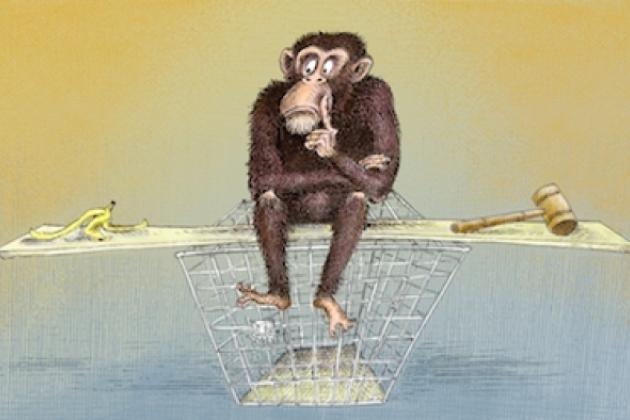- Law & Policy
Readers of the New York Times Magazine will have seen a photograph of an animatronic chimpanzee testifying at court on the cover of a recent edition. That chimp is supposed to represent Tommy. As the Times story details, lawyer Steven Wise seeks to represent Tommy in court, though Tommy is owned by Patrick and Diane Lavery who keep him in a cage in Gloversville, New York. Not surprisingly, some people are upset by the conditions of Tommy’s confinement. Wise, the president of the Nonhuman Rights Project (NRP), is one of those people.

Last December Wise filed a petition on Tommy’s behalf for a writ of habeas corpus in the court of Fulton County, New York. Habeas corpus is an ancient common law cause of action brought on behalf of persons who claim to be wrongly imprisoned. If a court concludes that the petitioner is held captive without legal cause, it orders the captor to release the captive. During the Civil War, President Abraham Lincoln suspended the writ of habeas corpus in the interest of better prosecuting the war, but as a general matter the writ has served for centuries as one of the most important common law protections of individual liberty.
So it makes sense. Wise believes that Tommy is wrongly imprisoned. What better remedy than habeas corpus? But even assuming it could be proven that Tommy is an illegal captive held against his will, Wise and his fellow lawyers face an enormous obstacle. For the entire history of the common law, the writ of habeas corpus has been available only to secure the release of wrongfully imprisoned persons. Tommy is not a person; he is a chimpanzee.
Of course Wise knows that. He knows that no American (or Anglo) court has ever issued a writ of habeas corpus ordering the release of a nonhuman creature. As their mission statement makes clear, the Nonhuman Rights Project exists to change that.
According to Wise, a chimpanzee was selected as the first test case because there are sanctuaries willing to take him in if he is released. But there is also little doubt that Tommy is the chosen petitioner because many people, including many judges, see something of themselves in a chimpanzee. Chimpanzees, who share 99 percent of their DNA with homo sapiens, eerily resemble humans in their appearance and behavior, even if we don’t dress them up in a coat and tie. There is probably a far better chance of persuading a judge to issue a writ of habeas corpus on behalf of a chimpanzee than a dolphin. For the Nonhuman Rights Project, chimpanzees are the first priority, then the other great apes, then dolphins, then whales, and so on.
What Wise is looking for is a judge willing to do what has never been done before. In the Times story, Wise is quoted as saying: “If we lose, we keep doing it again and again, until we find a judge . . . [willing] to make that leap of faith.” Wise does not explain what faith has to do with it, but if making a leap of faith means ignoring the law, that is exactly the sort of judge he needs. As the trial court judge in Tommy’s case found, notwithstanding his sympathies for Wise’s cause, there is no way to get to Wise’s endpoint while being consistent with the rule of law.
Wise and other animal rights advocates argue that there is a way within the law to recognize nonhuman rights. For Wise the key attribute a nonhuman creature must have to be eligible for rights is autonomy. Autonomous beings are able “to freely choose, to self-determine, to make their own decisions without acting from reflex or innate behavior.” Presumably this distinguishes chimpanzees from slugs and bugs, but there will remain a slippery slope down which the most advanced neurological and genetic understanding will not prevent our sliding. Not because those sciences will not continue to advance, but because the incentives for human exploitation of nonhuman rights claims will be as great as the incentives for human exploitation of the animals themselves.
Putting aside the difficult challenge of explaining which nonhuman creatures have rights and which do not, the root of the problem for a court is that, although Tommy may have the autonomy to choose where he goes and what he eats and he may resent captivity, he does not have the autonomy to file a petition for writ of habeas corpus. That must be done by a person who claims to act in Tommy’s interest. Who should Tommy’s surrogate be, and how does that person know what Tommy’s interests are?
Can we really know whether the NRP’s Steven Wise or Tommy’s owner/captor is better able to represent Tommy’s interests? Presumably the Laverys know Tommy far better than does Wise. It is easy to imagine ourselves in Tommy’s cage and conclude that we would rather be free to return to our homes, but we are humans, not chimpanzees. As far as we can know, Tommy may think the cage is his home.
What we can know is how we feel about a caged chimpanzee. It looks pretty cruel to most people, as do the confinement of hens in tiny cages and the butchering of elephants for their ivory. Which is why we have laws against cruelty to animals and prohibitions on trade in ivory. The lines we must draw are not easily drawn—between the humane killing of animals for food and the inhumane confinement and killing of animals for pleasure and profit. But we draw them nonetheless just as we settle on all questions of morality, on the basis of human understanding and human values. We condemn and punish mistreatment of animals because we care about them or are repulsed by their abuse, not because they have rights pursuant to which they can pursue their own values and preferences.
True, chimpanzees are a lot like humans in terms of DNA, but then so are dolphins and mice. The stark differences are in the details. The fact that chimpanzees appear a lot more similar to humans than do mice does not mean that humans are better able to know the interests of chimpanzees. We can no more know the interests of a chimpanzee than of a tree. While we might make better guesses about the interests of chimpanzees than trees, there is no escaping that our claims about both will reflect our own interests in the treatment and use of these nonhuman organisms.
Thus, the nonhuman rights strategy suffers from the same insurmountable obstacle as did Christopher Stone’s valiant effort four decades ago to establish that trees and other natural objects should have standing in our courts. Persons must allege legally cognizable injury to themselves to have standing in court. This assures that courts are being asked to resolve legal, not political, matters and that the person whose legal right is at stake is the person making the argument. Wise claims that the assertion of nonhuman rights somehow avoids the standing obstacle, but it falters on the same inability to know the interests of the nonhuman organism and therefore assure a court that the true interests being asserted are not those of the usually self-appointed representative.
With only a few exceptions, one person is not allowed to invoke the rights or interests of another person in our courts because we accept that only the person whose interests are at stake can know what those interests are and that that person will present the best case in support of their position. The exceptions are for infants and other individuals lacking the mental capacities of a normal human. In allowing these exceptions, we compromise the basic premise of individual autonomy and we risk exploitation of the cognitively undeveloped or impaired by the surrogate, but we do so in the belief that allowing another person (generally with family or other close ties to the person being represented) to rack changes such a person is more consistent with principle of autonomy than simply leaving outcomes to fate, government, or the choices of self-interested strangers.
For better or worse, the right relevant to Tommy’s current situation is that of his legal owner. Wise has argued that a court should view Tommy’s captivity in the same way Lord Mansfield did that of the American slave James Somerset in 1772. Mansfield held that Somerset was not legally confined on a slave ship bound for Jamaica because he was a legal person, not property. But as a legal person, Somerset could speak for himself in court. Only the Nonhuman Rights Project or some other third party can speak for Tommy.
If Tommy is being abused in some way, there are laws intended for his protection. If those laws are inadequate, the Nonhuman Rights Project can lobby for their amendment. Or the NHP could offer to purchase Tommy and release him to a chimpanzee sanctuary where Tommy’s life could be more like that NRP prefers for him. Of course, wherever Tommy might end up, a person will be responsible for his care and protection and for any harm that Tommy might cause to others.
With rights come responsibilities and Tommy is no better able to understand and perform responsibilities than to assert rights. There is no escaping that persons must do both on Tommy’s behalf without being able to know what his interests truly are if, indeed, he does have autonomous interests.
Because animals cannot speak for themselves, people will do the talking. Rather than allow some people to petition the courts as if they are the animals, it is better to recognize that Tommy and other nonhuman creatures on our shrinking planet exist at the mercy of humans and that individual humans have varying perspectives on the legitimate uses and treatment of animals. Such disagreements are best sorted out in the democratic legislative process with competing interests each making their best arguments.
Throughout the long history of the common law, rights have functioned like trumps in a card game. In a dispute between private parties or between an individual and government, the person with a right prevails to the extent of that right. It might be said that rights claims are sometimes balanced against the interests of others or of the community, but such balancing only serves to define the extent of the right. Thus, when Wise finally finds a judge willing to declare that a nonhuman creature has rights, he will have successfully trumped the legislative process in favor of his purposes, noble as they are. And he will have done so at the expense of the rule of law.















